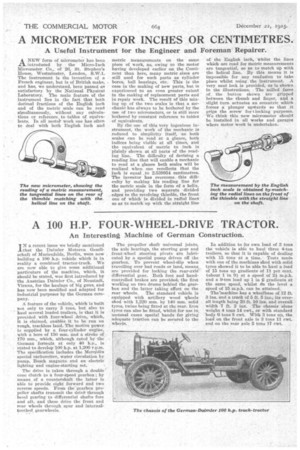A 100 H.P. FOUR-WHEEL-DRIVE TRACTOR.
Page 22

If you've noticed an error in this article please click here to report it so we can fix it.
An Interesting Machine of German Construction.
1N a recent issue we briefly mentioned that the Daimler Motoren Gesellschaft of Marienfeldt, Berlin, were now building a 100 h.p. vehicle which is in reality a combined tractor-truck. We are now able to give some additional particulars of the machine, which, it should be stated, was first introduced by the Austrian Daimler Co., of Neustadt, -Vienna, for the haulage of big guns, and has now been modified and adapted for industrial purposes by the German company.
A feature of the vehicle, which is built not only to carry 3 tons, but also to haul several loaded trailers, is that it is provided with four-wheel drive, which, it is claimed, enables it to be run on rough, trackless land. The motive power is supplied by a four-cylinder engine, with a bore of 150 mm. and a stroke of 170 ram., which, although rated by the German formula at only 40 h.p., is stated to develop 100 h.p. at 1,200 r.p.m. The specification includes the MerejRles special carburetter, water circulation by pump, Bosch magneto and an electric lighting and engine-starting set.
The drive is taken through a double cone clutch to a four-speed gearbox ; by means of a countershaft the latter is able to provide eight forward and two reverse speeds. From the'gearbox propeller shafts transmit the drive` through bevel gearing to differential shafts fore and aft, and these drive the front and rear wheels through spur and internaltoothed gearwheels.
The propeller shaft universal joints, the axle bearings, the steering gear and front-wheel steering pivots are lubricated by a special pump driven off the gearbox. To prevent wheel-slip when travelling over bad roads or land, means are provided for locking the rear-axle differential gear. Both foot and handcontrolled brakes are provided; the first working on two drums behind the gearbox and the latter taking effect On the
rear wheels. The standard vehicle is equipped with artillery wood wheels shod with 1,220 mm. by 140 mm. solid tyres, twins being fitted at the rear. Iron tyres can also be fitted, whilst for use in umisual eases special bands for giving, adequate traction can be secured to the wheels.
In addition to its own load of 3 tons the vehicle is able to haul three 4-ton trailers, so that it is capable of dealing with 15 tons at a time. Tests made with one of the machines shod with solid tyres showed it to be able to haul a load of 15 tons up gradients of 11 per cent. (about 1 in 9) at a speed of 2i m.p.h. and a 9-ton load up 1 in s gradients at the same speed, whilst an the level a speed of 15 m.p.h. can he attained. The-machine has a wheelbase of 12 ft.
ins. and a track of 5 ft. 5 ins., its overall length being 20 ft. 10 ins, and overall width 7 ft. 2 ins. The chassis alone weighs 4 tons 14 cwt., or with standard body 6 tons 8 cwt. With 3 tons up, the load on the front axle is 3 tons 11 cwt, and on the rear axle 5 tons 17 cwt.






























